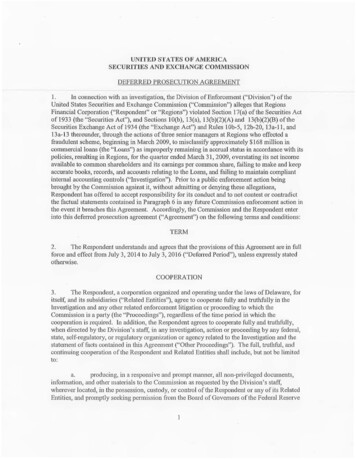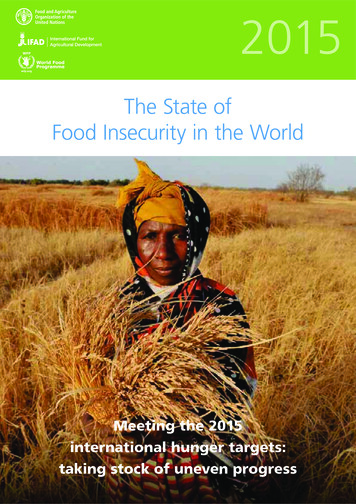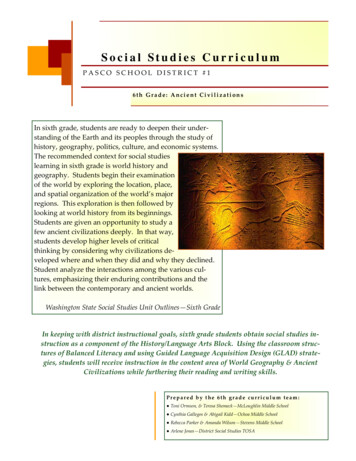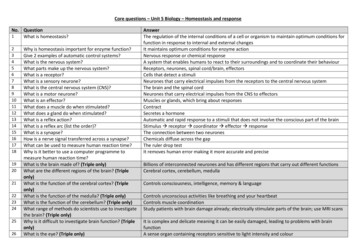
Transcription
Unit of Study:Regions of the United StatesWhere in the World Am I?Cypress-Fairbanks Independent School DistrictIntegrated Social Studies, Grade 4
Unit 2 - Week at a GlanceWeekINSS Instructional FocusReading WorkshopWriting WorkshopRevising & Editing1Map SkillsDramaPersonal NarrativeSingular & PluralNouns(BOY Reading DPM)(BOY R&E DPM)2Types of Regions(Population, Political,Economic)3Geographic Regions ofTexasFiction - use fictionselections fromAppendix A as readalouds for the week.Irregular PersonalNounsSubject-VerbAgreementLandforms & Climate4U.S. RegionsVerb TenseTexas Towns Past &Present5Technology Project(separate document iniXplore)NonfictionPrompt-basedPersonal NarrativeApostrophes inContractions &PossessivesGENERAL INFORMATION ABOUT UNIT The lessons in this unit are geared toward the 4th grade TEKS. Teachers are encouraged tomodify these activities as needed and choose resources that best fit their needs. INSSobjectives should be visible. Lessons should be integrated into the reading/writing workshopschedule during the following times; poetry, read aloud with accountable talk (20 minutes),independent reading and writing, group or share time. See the suggested schedule in iXplore. Please refer to Dates of Remembrance document in iXplore. Vocabulary & current events resources are located in iXplore in INSS Resources. In the Unit Overview, the Bloom’s verbs have been underlined and critical skills have beencolor coded. You can access Journey’s materials through the Think Central website. Some examples ofmaterials you can use for read a-louds include; the student e-book, leveled readers,vocabulary readers, decodable readers, and the write-in reader. Brain Pop has a new site called Brian Pop Educators. It is free to join and has some greatresources and lesson plans for all subjects. http://www.brainpop.com/educators/home/ If you have a Discovery Education account, you will need to sign-in before viewing the videoclips listed as resources.
Grade 4 Integrated Social Studies CurriculumUnit 2:Regions of the United StatesConceptual Lens:Locations and PatternsSocial Studies TEKS:Unit Overview:LiteratureSelections:Grade 4 Unit 2Unit Length:4 Weeks4.6(A) apply geographic tools, including grid systems, legends, symbols, scales, and compass roses,to construct and interpret maps4.6(B) translate geographic data, population distribution, and natural resources into a variety offormats such as graphs and maps4.7(A) describe a variety of regions in Texas and the United States such as political, population, andeconomic regions that result from patterns of human activity4.7(B) identify, locate, and compare the geographic regions of Texas (Mountains and Basins, GreatPlains, North Central Plains, Coastal Plains, including their landforms, climate, and vegetation;4.7(C) compare the geographic regions of Texas (Mountains and Basins, Great Plains, North CentralPlains, Coastal Plains) with regions of the United States and other parts of the world4.8(B) describe and explain the location and distribution of various towns and cities in Texas, past andpresent4.8(C) explain the geographic factors such as landforms and climate that influence patterns ofsettlement and the distribution of population in Texas, past and presentStudents will conduct a thorough study of regions in Texas and North America resulting from humanactivity and physical features. The location, distribution, and patterns of economic activities andsettlement in Texas further enhance the concept of regions. Also, the students will use geographictools to collect, analyze, and interpret data.Teachers may choose a variety of literature for the read aloud selections to develop students’understanding of the social studies concepts. See Appendix A for suggested titles.Page 1
Map Skills Overview: Week 1Enduring Understandings/GeneralizationsGeographic tools are used to collect, analyze, and interpretdata. Guiding/Essential QuestionsWhat is the purpose of a map?What is scale and how is it used on a map?What is a key of legend on a map?Why are there symbols on a map legend?What is a compass rose and why do we use it when readinga map? How do you read a grid map? How do you use geographic tools to construct and interpretmaps?Students will . . .participate in discussions and express ideas in a written format about the unit’s enduring understandings and guiding questionsuse primary and secondary sources to gain information about a topicunderstand key vocabulary termsapply geographic tools, including grid systems, legends, symbols, scales, and compass roses, to construct and interpret maps Instructional Resources-Week 1Teacher Materials Horizons Textbook-can be used as aread aloud or independent reading topractice reading skills.p. A2-3: Read a Mapp. 6-7: Why Geography Matters?p. 20-25: Where on Earth is Texas?p. 52-53: Map Making Tools Appendix B-Geography Review Appendix C-Map Guidelines Map Vocabulary PPT (iXplore) Blank U.S. Map (iXplore)Grade 4 Unit 2 Teacher NotesAn anchor chart canbe made for use duringthe week.Students can takenotes, draw pictures, ormake a vocabularyfoldable of the toolsand place in their ISNfor future reference.Teachers may chooseto incorporate R&E skillsinto the writing activitiesin this unit. Assessments (%)RA discussion andparticipation, including“turn and talks” and/or“stop and jots”Appendix DInterpreting a MapStudent created mapWriting activity TechnologyMap MakerTypes of MapsGlossary of Map TermsGridsPage 2
Map Skills Pacing Guide : Week 1 MondayVocabulary ReviewTeacher can useAppendix B to reviewgeography and mapskills and their purpose.Grid systemLegendSymbolScaleCompass roseInterpret (to read)Construct (to make)Apply TuesdayInterpret MapsReading a map is similarto reading informationaltext such as an article orbiography. We do so togain information.Discuss the meaning of“interpret”.Explain to student theywill be showing theirability to interpret orread a map forinformation bycompleting Appendix D:Interpreting a Map. (%) WednesdayThursdayMap ConstructionWhat does it mean to construct or createsomething?Teacher will review the guidelines forcreating a map in Appendix C.Students will construct a simple map of afamiliar area such as the schoolyard or theclassroom, using basic map symbols and amap legend!Enrichment: students can come up with 23 questions about their map to use fortomorrow’s lesson on interpreting maps.Have students pair up and answer thequestions about their partner’s mapcreated in the previous day’s lesson. Placein their ISN. (%) FridayWritingIn their writer’snotebook, write ashort paragraphdescribing the partsof the map andexplaining thefunctions of eachpart of reading amap. Have themtake turns readingtheir paragraph to apartner and addinginformation ifneeded. (%)Today is AmericanIndian Heritage Day.Suggested maps students could construct:Regions of TexasAmerican Indians in TexasFirst missions in TexasBattles of Texas RevolutionMajor cities in TexasGrade 4 Unit 2Page 3
Types of Regions Overview: Week 2Enduring Understandings/GeneralizationsSome areas of land are divided into several types of regionsbased on patterns in geography, politics, natural resources,and population. Guiding/Essential QuestionsWhat is a region?How are political, economic, and population regionsdetermined?How do geographers use the different regions?Why is it important to understand the patterns that determineeach of these types of regions?Students will . . . participate in discussions and express ideas in a written format about the unit’s enduring understandings and guiding questionsuse primary and secondary sources to gain information about a topicunderstand key vocabulary termsthink like a geographer and describe a variety of regions in Texas and the United States such as political, population, andeconomic regions that result from patterns of human activityTeacher Materials Horizons textbook- can be used as aread aloud or independent readingto practice reading skills.pp. A4-5: Political map of the worldp.6 - Regionsp. A8: Political map of WesternHemispherepp. A10-11: U.S. Mappp. A12-13: Political map of U.S.p. A16: Political map of Texaspp. 48-51:Political Regionspp. 54-57: Population Regionspp. 60-65: Economic Regions Appendix E-Regions Concept Map Texas Counties PDF (iXplore)Grade 4 Unit 2Instructional Resources-Week 2Assessments (%)Teacher Notes A great introduction tothis unit is the JohnnyCash song I’ve BeenEverywhere (iXplore).During the week, use aU.S. map to showstudents the differentregions being discussed. RA discussion andparticipation, including“turn and talks” and/or“stop and jots”Appendix E: RegionsConcept Map Technologyhttp://www.sheppardsoftware.com/web games.htmPolitical mapsPage 4
Types of Regions Pacing Guide : Week 2MondayVocabulary Prior to the lesson,create an anchorchart titled “Types ofRegions” or useAppendix E (seeinstructions below) Discuss the term“region” - regions areusually determinedby shared patterns. Add the definition tothe chart. Other VocabularyTerms Political region Population region Economic region TuesdayPolitical RegionsPolitical regions usuallyshare the samegovernment andleaders. Types ofpolitical regions includecountries (USA), states(Texas), counties (Harris,and cities (Houston).Conduct a RA thatdescribes the locationof places in the U.S.using political regions.Have students “turnand talk” during the RAto discuss whether aplace is beingdescribed by its naturalor political region andwhat text evidencethey have to back-uptheir answer. WednesdayPopulation RegionsNatural, economic,cultural, and politicalpatterns usuallydetermine populationregions.Conduct a RA thatdescribes the locationof places in the U.S.using populationregions.Have students “turnand talk” during the RAto discuss whether aplace is beingdescribed by its naturalor population regionand what textevidence they have toback-up their answer. ThursdayEconomic RegionsPatterns of naturalresources and industriesusually determineeconomic regions.Conduct a RA thatdescribes the locationof places in the U.S.using economicregions.Have students “turnand talk” during the RAto discuss whether aplace is beingdescribed by its naturalor economic regionand what textevidence they have toback-up their answer.FridayCurrent Events Directions for Appendix EHave students complete a web showing the 4 types of regions that are found in the U.S.Have students label the center of the web “The Regions of the U.S.”Have students label the four spokes with one of the types of region, political, economic, and population.Have students complete the web by adding the definition and examples of each type of region.Have students write a response on the back of their web that answers these questions;o How will understanding the types of regions and their patterns help you in your study of Texas history?o How will understanding the types of regions and their patterns help you and your family in everyday life?Grade 4 Unit 2Page 5
Geographic Regions of Texas Overview: Week 3Enduring Understandings/GeneralizationsThe concept or regions, how they are alike anddifferent, and how they influence patterns of settlement. Guiding/Essential Questions How are the four major regions of the U.S. alike and different? Where is each region located? What are some of the characteristics of each of the four regions? Why is it important to understand the patterns that determine thefour major regions of the U.S.? Which region is Houston located in?Students will . . .participate in discussions and express ideas in a written format about the unit’s enduring understandings and guiding questions.understand key vocabulary words and conceptsuse primary and secondary resourcesidentify, locate, and compare the geographic regions of Texas (Mountains and Basins, Great Plains, North Central Plains, CoastalPlains), including their landforms, climate, and vegetationexplain the geographic factors such as landforms and climate that influence patterns of settlement and the distribution ofpopulation in Texas, past and presentTeacher MaterialsMountains and Basins PPT (iXplore)North Central Plains PPT (iXplore)students can use as a resourceTexas Regions Pictures PPT (iXplore)students can use images for theirproject if needed.Regions of Texas Field Trip (iXplore)teachers can use as a RAAppendix G-Generic Grading Rubric(feel free to adjust as necessary)Appendix H-Regions of TexasInformation SheetsAppendix I-Regions QuizGrade 4 Unit 2Instructional Resources – Week 3Assessments (%)Teacher Notes Students can use thisresearch again in Unit 3 Native American Groups.There are maps that show7 regions of Texas asopposed to the major 4. RA discussion andparticipation,including “turn andtalks” and/or “stopand jots”Appendix F-NoteTaking sheetRegion PosterRegions Quiz TechnologyU.S. Geographic RegionsTour Texas: Texas RegionsTexas Parks and Wildlife:Regions of TexasDiscovering the Regions ofTexasEnchanted Learning-NaturalFeatures of TexasEyes on TexasEscape to TexasLandformsPage 6
Geographic Regions of Texas Pacing Guide : Week 3MondayRead AloudMountains and BasinsLandforms – mountains,canyons, and dry plateausClimate – hot summers,cold wintersVegetation – cactus, shrubsTuesdayRA/IndependentReading & WritingGreat PlainsLandforms – plains,plateaus, escarpments,canyonsClimate – hot summers,cold winters, dryVegetation – cotton,wheat, short grasses, shrubsWednesdayRA/IndependentReading & WritingNorth Central PlainsLandforms – rolling prairies,forests, riversClimate – hot summers,cool winters, known fortornadoes, dryVegetation – grasses,shrubs, small treesThursdayRA/IndependentReading & WritingCoastal PlainsLandforms – plains, rivers,hills, desert, islands alongthe coast, bayous,escarpmentsClimate – mild winters andsummers, humidVegetation – short grasses,forests, shrubs Conduct a RA using the Regions of Texas Field Trip PPT. Explain that students will be studying the fourdifferent regions of Texas. Divide the students into four separate groups (region investigators) and assign them a region. Hand outthe note-taking sheet (Appendix F) and the information sheets for each region (Appendix G). The notetaking sheet can be glued, taped or stapled into the ISN. Students will read the information sheets to complete the note-taking sheet. They can also visit theinformational websites linked to the regions mentioned above or have access to the PPTs in the Teachermaterials section. Students will use the information they learned about their region and decorate their poster, illustratinglandforms, climate, animals, plants, and major cities of that region. Students can use markers, mappencils, or crayons to draw landforms, animals, plants and to mark major cities. Students can tear upconstruction paper or crumble up colored paper to illustrate landforms such as forests (green),mountains (brown), deserts (yellow), or water (blue), etc. Students can print out pictures of animals andplants found in their region via the internet, and glue them onto the poster board. Teacher can monitor students while they read and take notes about the regions. Assist with readingand note taking as needed.Grade 4 Unit 2FridayRA/IndependentReading & WritingPresent Posters- Haveeach group share theirposter and explain thevarious elementsillustrated on theirregion of Texas.Students should listencarefully so they canchoose a region tocompare to the onethey researched.Optional Activity:Complete theAnthropologists PPTslide. (iXplore)Page 7
U.S. Regions & Texas Towns Overview: Week 4Enduring Understandings/GeneralizationsRegions have similarities and differences across thestate, country and the world. Guiding/Essential Questions What region of the U.S. is Texas in? Are there similarities in how the regions are divided? How does the past reflect the present?Location and distribution of towns in Texas depends on Is change good or bad?many factors. What makes a town or city grow and prosper and what causes it tobecome a ghost town? How does climate play a part in how cities are formed? How do natural landforms affect where a city is formed?Students will be able to . . .participate in discussions and express ideas in a written format about the unit’s enduring understandings and guiding questions.understand key vocabulary words and conceptsuse primary and secondary resourcesdescribe and explain the location and distribution of various towns and cities in Texas, past and presentexplain the geographic factors such as landforms and climate that influence patterns of settlement and the distribution ofpopulation in Texas, past and presentcompare the geographic regions of Texas with regions of the United States and other parts of the worldTeacher MaterialsHorizons textbookHouston, p. 39, 51, 57, 221, 229,251, 306, 321, 329, 343Austin, p. 57, 221, 230, 231, 239,336, 376, 424Appendix J-Map of Texas, U.S., andworld Regions – use for compareand contrast activityAppendix K-The story of Bammel,Texas-ghost townTFK Teachers Guide p. 41-44Grade 4 Unit 2Instructional Resources- Week 4Assessments (%)Teacher Notes RA discussion andparticipation, including“turn and talks” and/or“stop and jots.”Venn Diagramparticipation TechnologyStates and RegionsInteractiveThinkQuest U.S. RegionsInformation site – click on theregion and see informationabout that region.Ghost Towns of the GulfCoastHouston’s Days of YorePage 8
U.S. Regions & Texas Towns Pacing Guide: Week 4MondayHolidayColumbusDayTuesdayVocabularyTeacher can conductactivities using suggestedvocabulary words to buildbackground knowledge. Compare Contrast Location DistributionReview the followingconcepts: Region Climate LandformsWednesdayRead Aloud w/ Accountable TalkFocus: Prior to the lesson, teachersneed to create a Venndiagram on chart paper or usean electronic version. Have students think back tothe information from lastweek’s lessons. Look at the region maps ofTexas and the U.S. (Appendix J) Start a discussion using thefollowing questions. What region of the U.S. is Texasin? Are there similarities in how theregions are divided? ThursdayFridayRead Aloud/Independent ReadingFocus: Texas Cities Now and in the Past – there aremany factors that cause a town grow and prosperor dwindle and fail.What makes a town or city grow and prosper andwhat causes it to become a ghost town? Givestudents a chance to brainstorm some ideas aboutfactors that would make people move to a cityand factors that would make people move away.In their ISN, have students write as many Texastowns as they can. Give them 2-3 minutes on atimer. Call on a few students to tell what theywrote down.Think about cities like Houston, Austin, Dallas, andSan Antonio. Are they prosperous, successfulcities? Why?Have you ever heard of Bammel, Tx? Conduct aread aloud using the story of Bammel, TX (a ghosttown) from Appendix K.Houston History: "The city began on August 30, 1836, when Augustus Chapman Allen and John KirbyAllenqqv ran an advertisement in the Telegraph and Texas Register for the "Town of Houston." Thetownsite, which featured a mixture of timber and grassland, was on the level Coastal Plain in the middle ofthe future Harris County, at 95.4 west longitude and 30.3 north latitude."Grade 4 Unit 2Page 9
TopicMap cSuggested Literature Got Geography by Lee Bennett Hopkins The Journey of Oliver K. Woodman by Darcy Pattison The Little Man in the Map by E. Andrew Martonyi Armadillo form Amarillo, Lynne Cherry From Here to There by Margery Cuyler Kate Heads West by Pat Brisson Kate on the Coast by Pat Brisson Your Best Friend, Kate by Pat Brisson LaRue Across America: Postcards From the Vacation by Mark Teague Wow! America by Robert Neubecker Flat Stanley books by Jeff Brown Americana Adventure by Michael Garland My America: A Poetry Atlas of the United States by Lee Bennette Hopkins This Land is Your Land by Woody Guthrie How to Make a Cherry Pie and see the U.S.A. by Marjorie Priceman All Around Texas: Regions & Resources, Mary Dodson Wade TFK Reader: Austin, TexasTexas TownsGrade 4 Unit 2Appendix A
Review of Geographic ToolsMaps use a key, or legend to explain the meaning of each of the symbolsused in the map.A compassrose is usedfor showingcardinaldirections.A grid is a series of evenlyspaced imaginary linesthat intersect with oneanother at right angles.One set of lines aredistributed across theglobe horizontally, andone set of lines aredistributed vertically.Scale (map): The scale of a map is defined asthe ratio of a distance on the map to the actualdistance on the ground.Many maps can have atitle.Grade 4 Unit 2Appendix B
Map GuidelinesYour map should include the following elements: A neatly drawn map of any environment such as your classroom,school, neighborhood, or place you have visited. All areas or features of the map must be correctly labeled andcapitalized (use best handwriting) Students can choose to create a scale map with the samerequirements. A map title of your creation that is capitalized correctly A compass rose with cardinal directions A map scale A map key with symbols that match areas shown on the map (Usedifferent colors to make is easier to read)Rubric:Grade 4 Unit 2Appendix C
Name:Date:Interpreting a MapGrade 4 Unit 2Appendix D
Name: Date:Regions Concept MapTypes ofRegions inthe TexasPopulationRegionsWhat is aregion?PoliticalRegionsEconomicRegionsGrade 4 Unit 2Appendix E
Why would a personchoose to live in thisregion?Grade 4 Unit 2Appendix F
Generic Poster Grading RubricUse of Class TimeGraphics - OriginalityRequired ElementsContent - AccuracyGrammarLabelsGrade 4 Unit 2Used time wellduring each classperiod. Focusedon getting theproject done.Never distractedothers.Used time wellduring each classperiod. Usuallyfocused ongetting the projectdone and neverdistracted others.Did not use classtime to focus onthe project ORoften distractedothers.One or two of thegraphics used onthe poster reflectstudent creativityin their creationand/or display.Used some of thetime well duringeach classperiod. There wassome focus ongetting the projectdone butoccasionallydistracted others.The graphics aremade by thestudent, but arebased on thedesigns or ideasof others.Several of thegraphics used onthe poster reflectan exceptionaldegree of studentcreativity in theircreation and/ordisplay.The posterincludes allrequired elementsas well asadditionalinformation.At least 7accurate facts aredisplayed on theposter.There are nogrammaticalmistakes on theposter.All requiredelements areincluded on theposter.All but 1 of therequired elementsis included on theposter.Several requiredelements weremissing.5-6 accurate factsare displayed onthe poster.3-4 accurate factsare displayed onthe poster.There is 1grammaticalmistake on theposter.There are 2grammaticalmistakes on theposter.Almost all itemsof importance onthe poster areclearly labeledwith labels thatcan be read fromat least 3 ft.away.Several items ofimportance on theposter are clearlylabeled withlabels that can beread from at least3 ft. away.Less than 3accurate facts aredisplayed on theposter.There are morethan 2grammaticalmistakes on theposter.Labels are toosmall to view ORno importantitems werelabeled.All items ofimportance on theposter are clearlylabeled withlabels that can beread from at least3 ft. away.No graphicsmade by thestudent areincluded.Appendix G
Central Plains Information SheetSub-RegionsGrand PrairieCross TimbersRolling PlainsPrairie & LakesThe Central Plains is usually hot in the summer and can get pretty cold inthe winter. Sometimes it might even snow! The region can get anywhere from 20to more than 40 inches of rain a year. This region is part of “Tornado Alley”which means that sometimes bad storms can bring tornados. A tornado is afierce and swirling funnel of wind.This region is bound by the Caprock Escarpment to the west, the EdwardsPlateau to the south, and the Eastern Cross Timbers to the east. This areaincludes the cities of Abilene, Wichita Falls, Fort Worth, Grand Prairie, and Dallas.With about 35 to 50 inches annual rainfall, gently rolling to hilly forestedland is part of a larger pine-hardwood forest of oaks, hickories, elm, andgum trees. Soils vary from coarse sands to tight clays or red-bed clays andshales.The only National Park in this region is the Lake Meredith NationalRecreation Area.http://en.wikipedia.org/wiki/Geography of Texas#Interior LowlandsGrade 4 Unit 2Appendix H
Great Plains Information SheetSub-RegionsHigh PlainsEdwards PlateauLlano Basin (Hill Country)The Great Plains is hot in the summer, but can get very cold in the winter.During the fall and winter, storms from Canada can blow through the areabringing a type of weather called a “blue northern”. A “northern” is a powerfulmass of cold air. These freezing blasts turn the sky a bluish-black color. It canmake the temperature drop 50 degrees in just two hours!These “northerners” can often bring blizzards, a storm with high winds,snow and ice. Between 1886 and 1887, a severe blizzard hit the area andnearly ruined the cattle industry by freezing many cows to death. This area canalso see tornados as it is part of an area of the country called “tornado alley”.This region includes the Llano Estacado, the Panhandle, Edwards Plateau,Toyah Basin, and the Llano Uplift. It is bordered on the east by the CaprockEscarpment in the panhandle and by the Balcones Fault to the southeast.Cities in this region include Austin, San Angelo, Midland, Odessa, Lubbock,and Amarillo. The Hill Country is a popular name for the area of hills along theBalcones Escarpment and is a transitional area between the Great Plains andthe Coastal Plains.With about 15 to 31 inches annual rainfall, the southern end of the GreatPlains are gently rolling plains of shrub and grassland, and home to the dramaticCaprock Canyons and Palo Duro Canyon state parks.National Parks in this area are the Lyndon b. Johnson National HistoricalPark and the San Antonio Missions National Historical Park.http://en.wikipedia.org/wiki/Geography of Texas#Great PlainsGrade 4 Unit 2Appendix H
Gulf Coastal Plains Information SheetSub-RegionsPiney WoodsGulf Coastal PlainsSouth Texas PlainPost Oak BeltBlackland PrairieThe Gulf Coastal Plains is very hot during the summer, reach temperaturesover 100 degrees. It also gets the most rainfall of all the regions of Texas. Theregion can get anywhere from 20 to more than 50 inches of rain a year.Because the region is right along the coast, the Gulf Coastal Plains willsometimes be hit by hurricanes. Hurricanes are violent storms with high windsand heavy rains. In 1900, a huge hurricane wiped out the city of Galveston,destroying buildings and killing more than 6,000 people. More than 100 yearslater, many consider it to be one of the worst natural disasters in United Stateshistory.The Coastal Plains includes the barrier islands off the coast of Texas. Thisregion stretches from Paris to San Antonio to Del Rio.This region has about 20 to 58 inches annual rainfall making a wide varietyof vegetation plentiful. The area is a nearly level, drained plain dissected bystreams and rivers flowing into estuaries and marshes. Sand, dunes, grasslandsand salt marshes make up the areas nearest to the sea.This region is home to the Big Thicket National Preserve, Padre IslandNational Seashore, and Palo Alto Battlefield National Historic Site.http://en.wikipedia.org/wiki/Geography of Texas#Gulf Coastal PlainsGrade 4 Unit 2Appendix H
Mountains and Basins Information SheetSub-RegionsWest of Pecos RiverUpper Rio Grande ValleyThe Mountains and Basins region is the driest area of Texas.Desert covers much of the region. Up in the mountain areas, thetemperature can get really cold in the winter and mild in thesummer, but down in the desert, it can reach well over 100 degreesin the summer. The area receives less than 10 inches of rain a year.The region is in extreme western Texas, west of the PecosRiver beginning with the Davis Mountains on the east and the RioGrande to its west and south.The region is the only part of Texas regarded as mountainousand includes seven named peaks in elevation greater than8,000 feet. With less than 12 inches annual rainfall, this regionincludes sand hills, desert valleys, wooded mountain slopes anddesert grasslands.The vegetation diversity includes at least 268 grass species and447 species of woody plants.National Parks include the Guadalupe Mountains NationalPark, Rio Grande Wild and Scenic River, and Fort Davis NationalHistoric Site.http://en.wikipedia.org/wiki/Geography of Texas#Basin and Range ProvinceGrade 4 Unit 2Appendix H
Name:Date:Label and color the 4 different regions of Texas.Grade 4 Unit 2Appendix I
Compare and Contrast Regions of Texas, the U.S., and the WorldGrade 4 Unit 2Appendix J
Grade 4 Unit 2Appendix J
Grade 4 Unit 2Appendix J
Where Bammel once wasPhoto courtesy Ken Rudine, May 2010Bammel is now considered a ghost town. Why?Grade 4 Unit 2Appendix K
Grade 4 Unit 2 Page 1 Grade 4 Integrated Social Studies Curriculum Unit 2: Regions of the United States Unit Length: 4 Weeks Conceptual Lens: Locations and Patterns Social Studies TEKS: 4.6(A) apply geographic tools, including grid systems, legends, symbols, s










